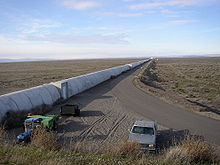Interferometric detector
An interferometric detector is a detector that uses the interference effects of light to detect gravitational waves . The detector consists of two tunnels that meet at an angle of ninety degrees, in which laser beams are sent back and forth and come together again at a photodiode. If a gravitational wave from space hits this tunnel system, according to the general theory of relativity one of the two arms of the interferometer should contract while the other one expands and this should lead to differences in the time of flight of the laser beams. These spatial distortions are extremely small - even the most violent events in the universe would only change the relative length of the tunnels to the 20th place after the decimal point. For this reason, the interferometer arms of all gravitational wave detectors built so far are relatively long (up to four kilometers). However, the changes in length are smaller than the diameter of an atomic nucleus , so the measurements must be very precise.
Work according to this principle:
- LIGO , 4000 meters in length, locations Hanford Site ( Washington ) and Livingston
- GEO600 , 600 meters long
- TAMA 300, 300 meters long, Mitaka , Japan ( 35 ° 40 ′ 35.9 ″ N , 139 ° 32 ′ 10.5 ″ E )
- VIRGO , 3000 meters (effectively 120 kilometers), Cascina , Italy ( 43 ° 37 ′ 53 ″ N , 10 ° 30 ′ 18 ″ E )
- CLIO (Cryogenic Laser Interferometer Observatory), 100 meters long, 1000 meters underground in the Kamioka Mine , Japan
Under construction or planned are:
- KAGRA (formerly Large-scale Cryogenic Gravitational wave Telescope, LCGT), 3000 meters long, successor to CLIO at the same location
- AIGO (Australian Interferometric Gravitational Observatory), near Gingin , in western Australia ( 31 ° 21 ′ 28 ″ S , 115 ° 42 ′ 50 ″ E )
- Laser Interferometer Space Antenna with a base length of five million kilometers in space
Web links
- RWTH Aachen University: The Search for Gravitational Waves (PDF, 6.57 MB)
- AIGO homepage
- TAMA 300
- Description of VIRGO
Individual evidence
- ↑ Cryogenic systems of the Cryogenic Laser Interferometer Observatory ( page no longer available , search in web archives ) Info: The link was automatically marked as defective. Please check the link according to the instructions and then remove this notice.

